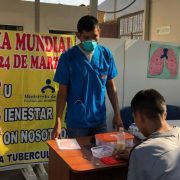For more than four decades, scientists have noticed a mysterious chemical in the treated drinking water of millions of people in the United States, but no one’s been able to pinpoint exactly what it is – until now.
The authors of a study published Thursday in the journal Science believe the chemical – which they named chloronitramide anion – is a decomposition byproduct of chloramine, a chemical that many treatment plants use to make water safe to drink. About 113 million people drink tap water that exposes them to chloronitramide anion, the study says.
It’s not clear whether the byproduct could be harmful to human health, but the study authors say its properties are similar to those of other molecules that are toxic enough for the government to regulate them.
And there is some precedent, the researchers say, for chemicals that are used to purify drinking water creating byproducts that the US Environmental Protection Agency must regulate because they are likely carcinogens.
In the early 20th century, many public water systems started using chlorine in low levels to make drinking water safe.
It solved a major public health problem that had plagued leaders for centuries by ridding the water of cholera and typhoid, deadly germs that can spread through drinking water. But it also caused its own health problems.
Epidemiological studies showed that some people who drink chlorinated water over a long period of time have a higher risk of colon and bladder cancers. For pregnant people who drink chlorinated water there was also a potential association with miscarriages and people who gave birth to babies with low birth weights.
Although chlorine itself is safe to consume at low levels, research showed that toxic byproducts were created when it came into contact with other elements that naturally occurred in the water.
Water systems still use chlorine for purification, but the EPA monitors and limits the amount of byproducts in drinking water to ensure that it is safe for human consumption.
Some systems switched to chloramine, a compound created when chlorine and ammonia are combined. Chloramine doesn’t seem to have the same potentially dangerous byproducts as chlorine, and it was more stable and tended to last longer.
More recently, scientists started noticing that chloramine also created byproducts. Some were familiar, but one remained a mystery, dogging study co-authors Dr. Julian Fairey and Dr. David Wahman for years.
“There’s this outstanding mystery compound in the literature that’s always been out there,” Fairey said Tuesday.
After graduate school at the University of Texas, Fairey and Wahman went on to study chloramine chemistry – Wahman at the EPA and Fairey at the University of Arkansas – and they decided they wanted to pin down this unnamed, unknown compound that had been showing up in research for about 40 years.
It seemed straightforward at first, but it took them 15 years to solve the mystery.
One of the first people they asked for help was Dr. Juliana Laszakovits, an expert in mass spectrometry, an analytical tool that can measure mass-to-charge ratio and determine a substance’s exact molecular weight.
“My first thought is, ‘let’s get this on a mass spectrometer, and let’s try and determine its accurate mass, so then we can determine its chemical formula,’ ” said Laszakovits, a co-author of the study who works in the department of environmental chemistry at the Institute of Biogeochemistry and Pollutant Dynamics, ETH Zurich.
But she quickly learned that there was a reason this substance had remained a mystery for so long. Water samples that contained the substance had high salinity, much higher than that of salt water. It was difficult to separate the compound from all the salts with the mass spectrometer.
Laszakovits had to get creative and use a technique called ion chromatography, which separates and analyzes ions and polar molecules, coupled with mass spectrometry.
“This combination of techniques isn’t so commonly used in environmental studies,” Laszakovits said. But it did the trick: She was able to separate the compound to get its mass and then help figure out its chemical formula.
Dr. Kristopher McNeill, a co-author of the study and a professor of environmental chemistry at ETH Zurich, confirmed its structure, and Fairey then created the same compound using a different technique to show the similarities.
Wanting to prove that the substance was a byproduct of disintegrating chloramines, Wahman looked for it in drinking water systems across the US that used the chemical and compared it with systems in Switzerland that didn’t.
He found chloronitramide anions in the water with chloramines but not in the Swiss water systems.
Although the team learned a lot about chloronitramide anions, they couldn’t determine whether it hurt human health.
“Its toxicity is currently unknown,” Fairey said. “Its presence is expected, quite honestly, in all chlorinated drinking waters to some extent because of the chemistry, and it has similarity to other toxic molecules. Therefore, future research on chloronitramide anion is needed to understand its potential implications in drinking water.”
Water expert Dr. David Sedlak called the research a “fascinating story and a very nice piece of science.”
“Chloramines have their own families of disinfection byproducts that they make, and so maybe the last 30 years we’ve seen a little bit of buyer’s remorse for this switch from free chlorine to chloramines, because we keep discovering these chloramine disinfection byproducts,” said Sedlak, vice chair for graduate studies and the Plato Malozemoff Professor of Environmental Engineering at UC Berkeley, who was not involved with the new research.
“The challenge is, we don’t really know about the health impacts, because unlike the free chlorine disinfection byproducts, there just hasn’t been as much toxicology done on these compounds.”
Local water systems don’t have the funding to investigate the health effects of these byproducts, Sedlak said, so it will be up to the federal government.
- Sign up here to get The Results Are In with Dr. Sanjay Gupta every Friday from the CNN Health team.
“It’s pretty expensive to look at these things, and when you think about the kind of money that we spend on understanding whether new drugs are toxic to patients, we should be willing to spend that kind of money to understand whether our water is safe to drink or not,” he said.
“It’s the kind of thing that, when government is functioning well, it does a good job protecting us by looking at these things. But I don’t think the EPA or CDC or NIH has the funding needed to answer these questions,” he said.
Oliver Jones, a professor of chemistry at RMIT University in Melbourne, said the study does some elegant chemistry and he is “quite convinced by their analytical evidence” that the unknown compound is chloronitramide anion. Although he agrees that a toxicological investigation of the anion would be useful now that its identity is known, “I’m not overly worried about my tap water,” Jones said.
“The compound in question is not newly discovered, just newly defined,” Jones told the Australian Science Media Centre. “We should remember that the presence of a compound does not automatically mean it is causing harm.”
Everything can be toxic at the right amount, even water, he said. The question is, is it toxic at the level people are exposed to? “I think the answer is probably not,” Jones said.
The authors of the study suggest that in the meantime, if people are concerned about their drinking water, while they don’t know for sure if it would work, a simple filter may help.
“I think a Brita filter or something like that is probably logical, in terms of any kind of carbon-based filter that you have in your refrigerator would probably remove it if someone was concerned,” Wahman said.





